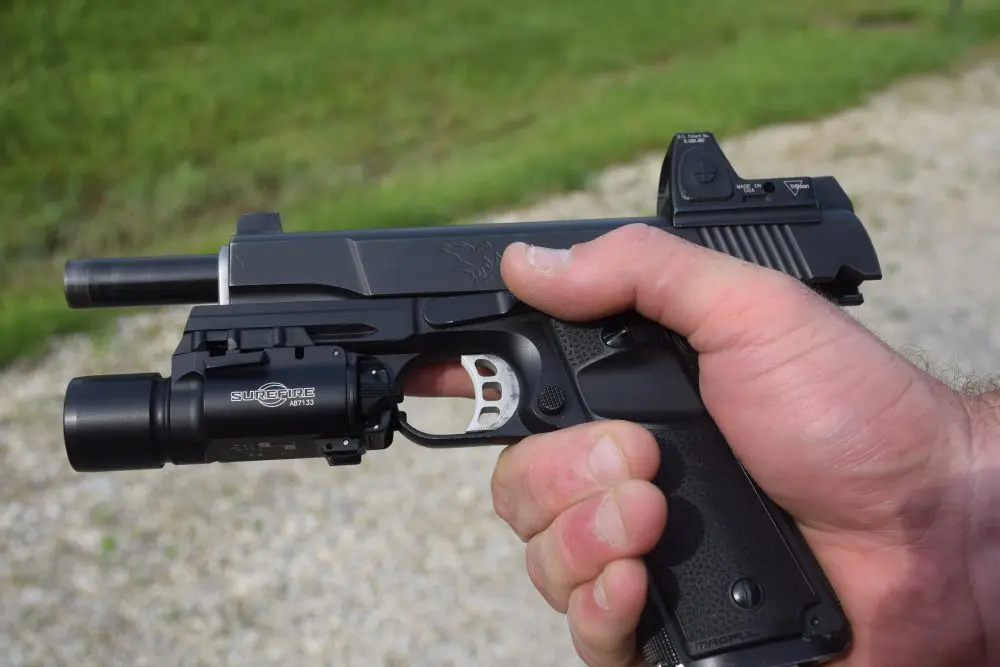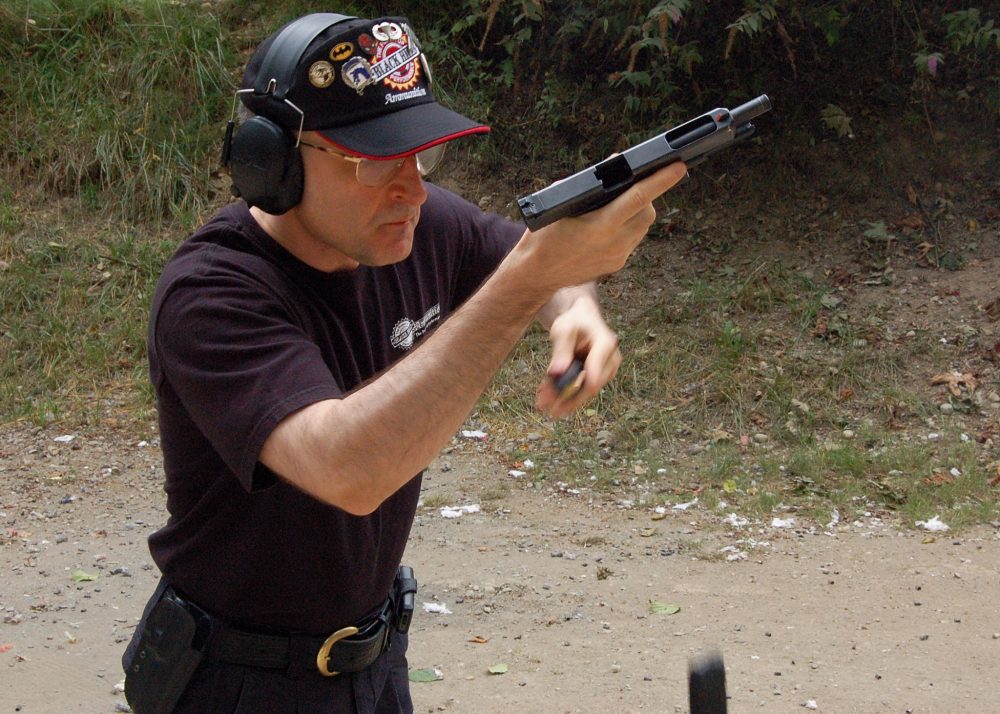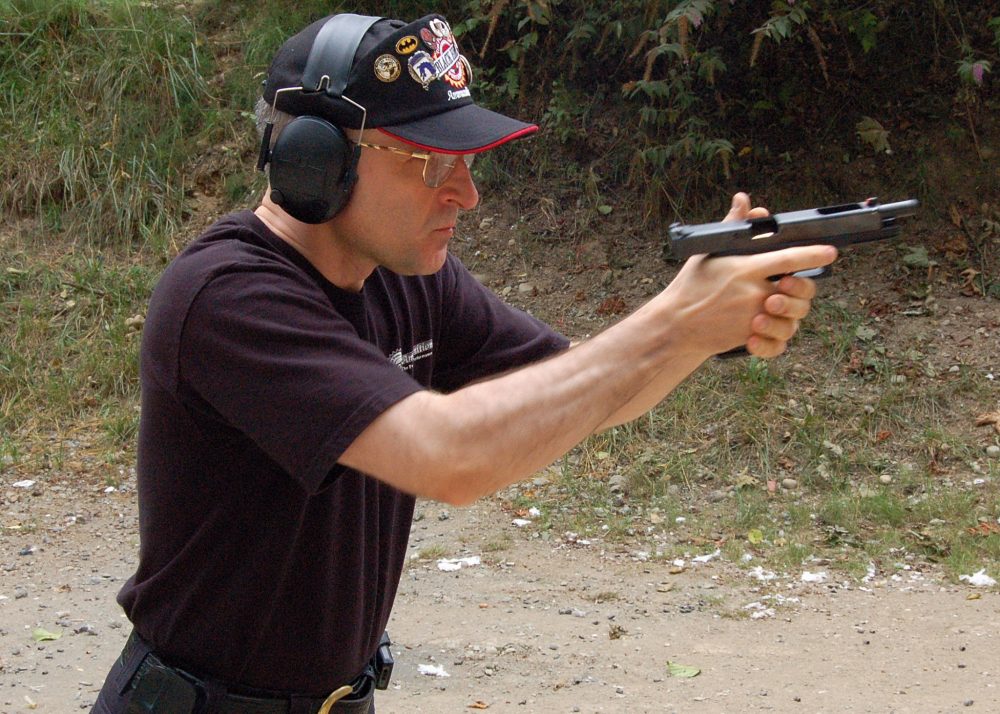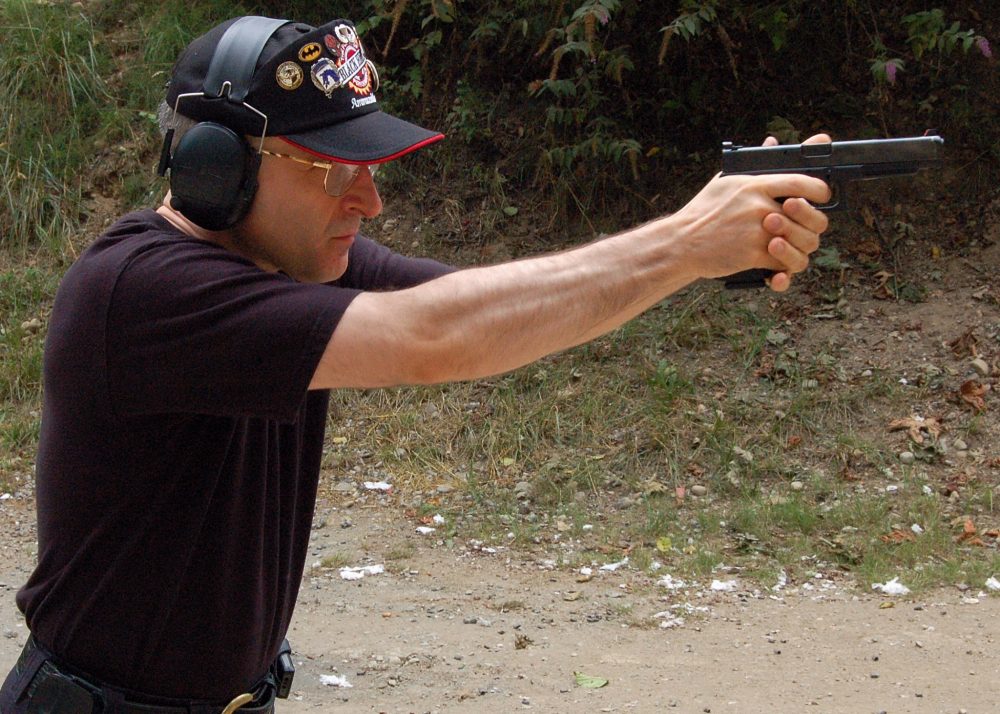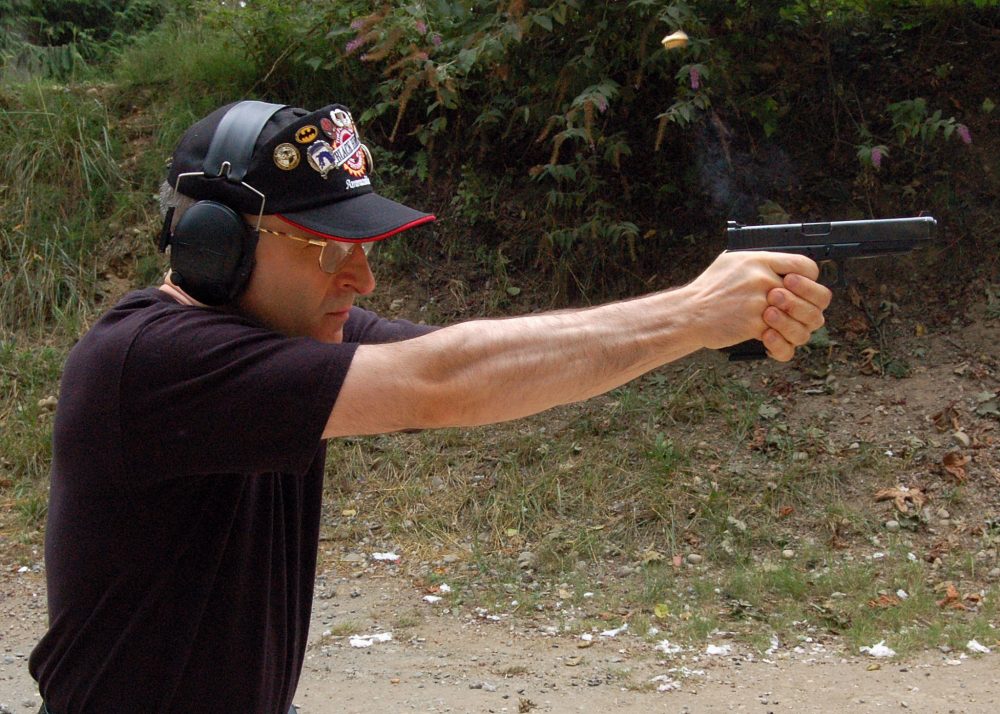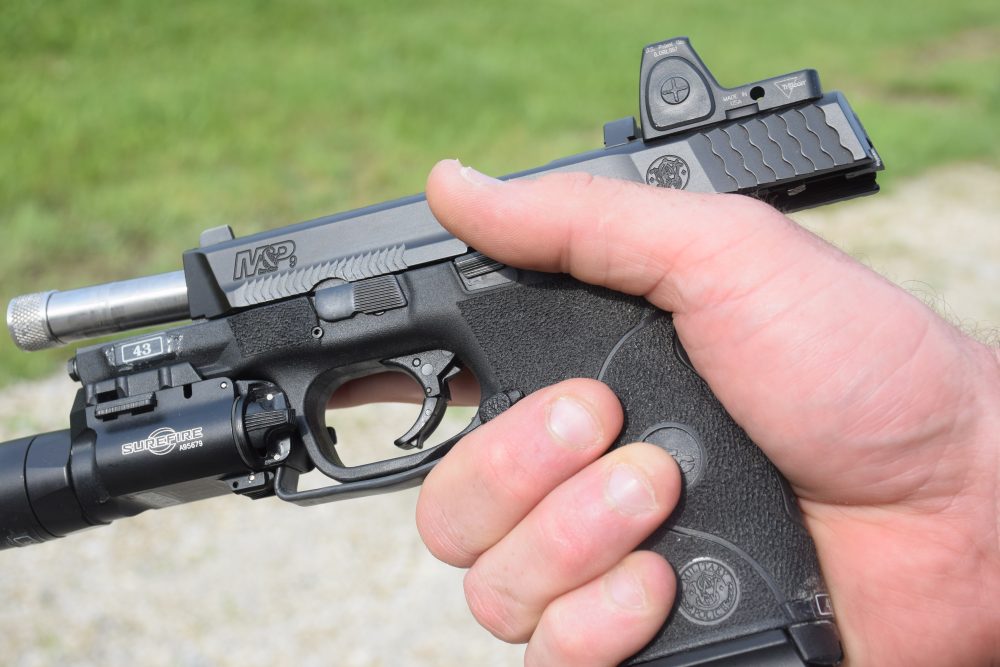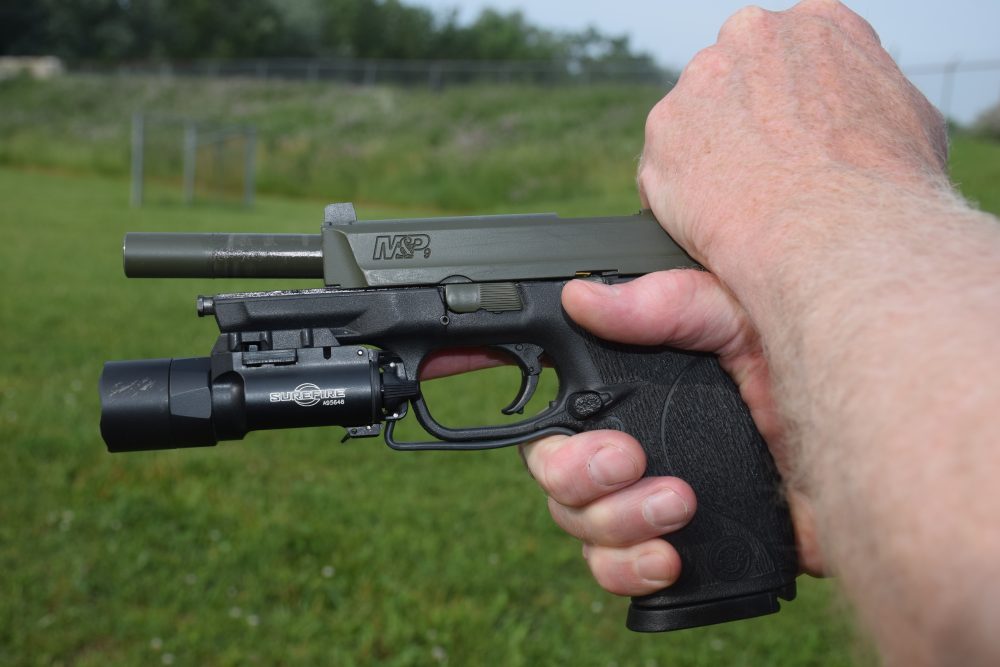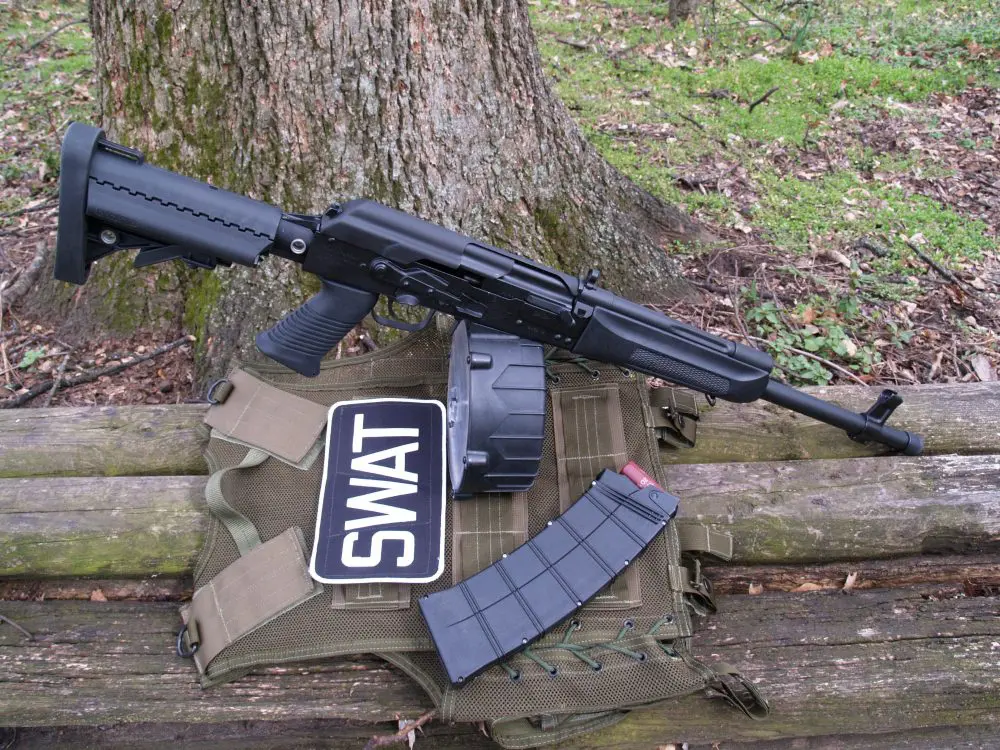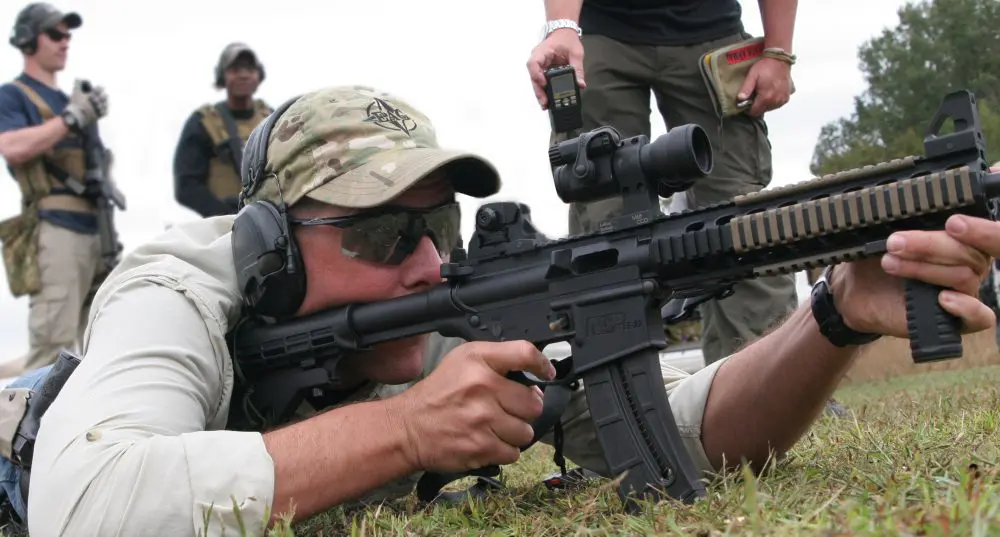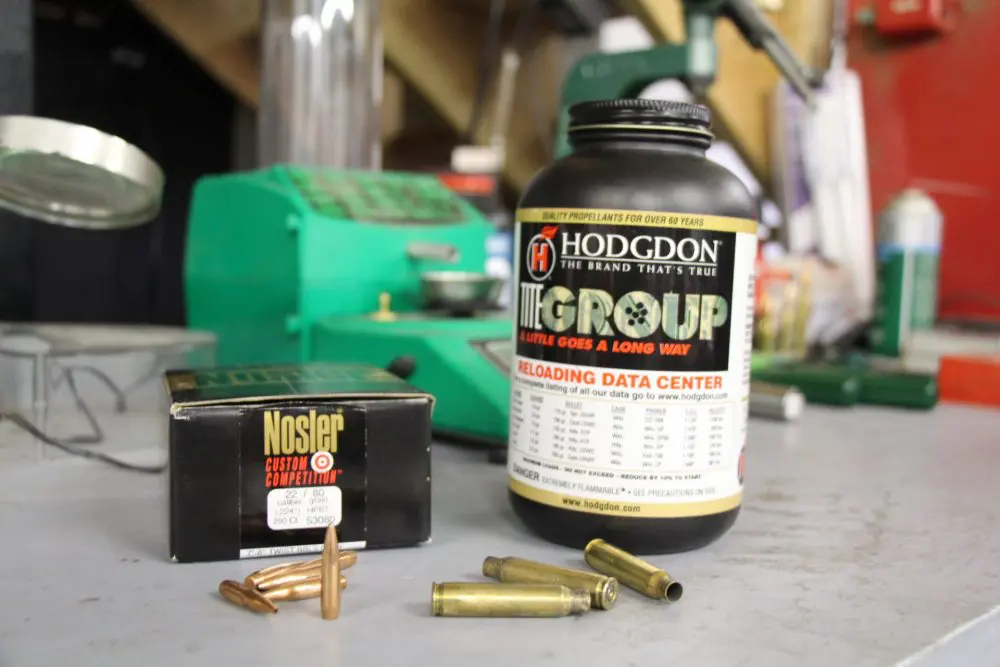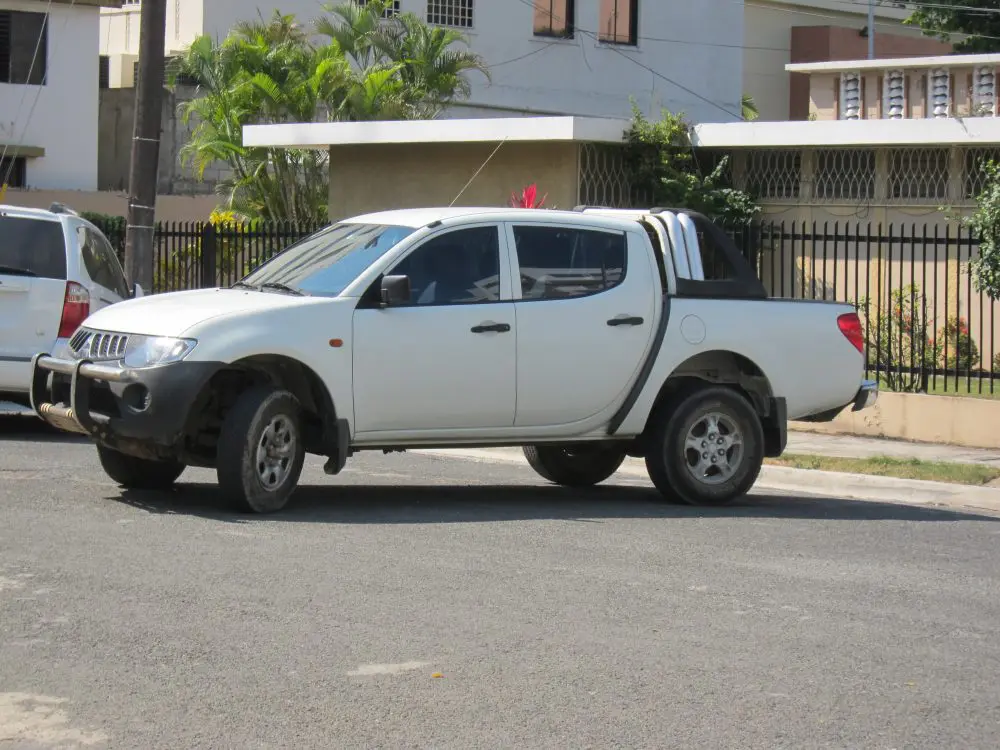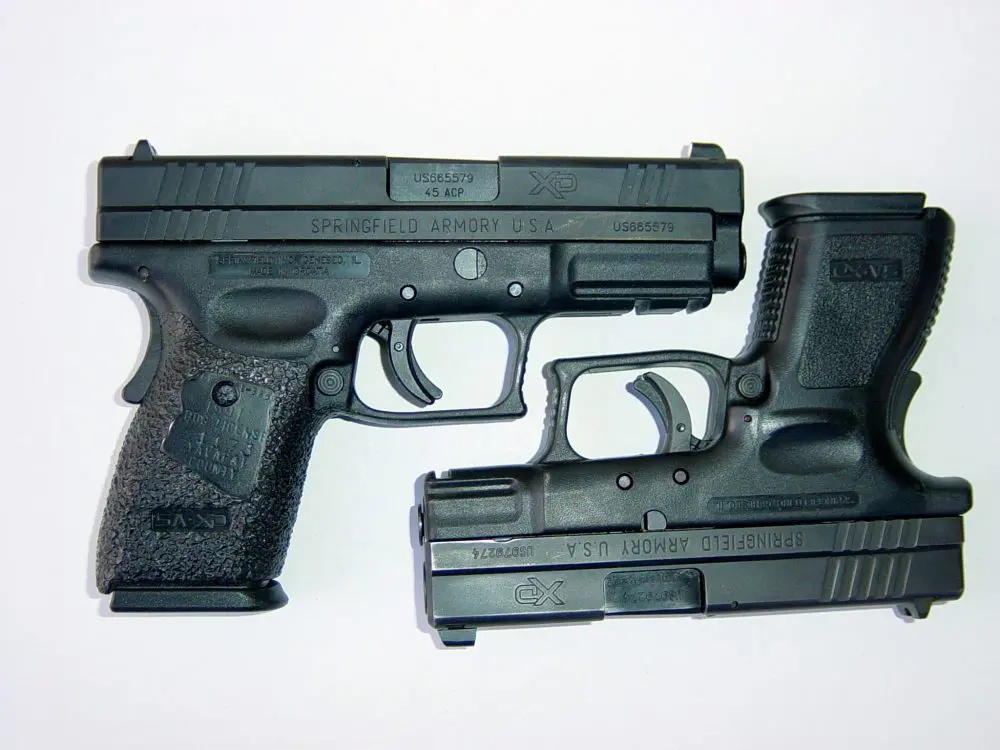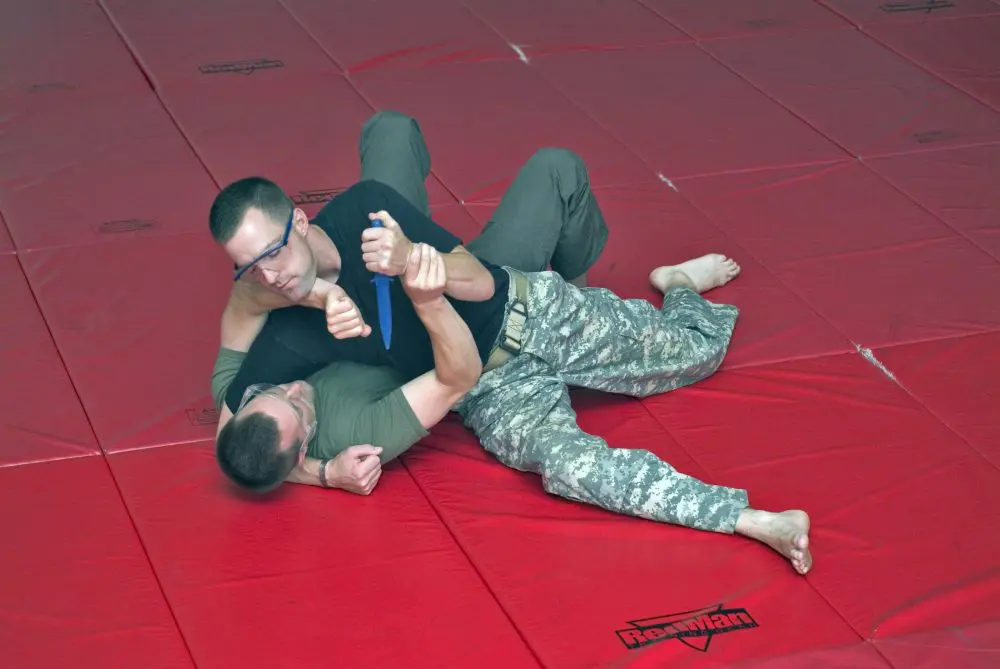Editor’s Note: How to operate firearms most efficiently has always been a contentious subject. One example is how to release the slide of an auto-pistol when it has locked back after the last round has been fired. The two most common ways are racking the slide back and releasing it, or using the slide-lock lever on the pistol. We present both the “point” and “counterpoint” arguments here for your consideration.
Table of Contents
POINT
by Duane Thomas
Two techniques are commonly taught to get the slide forward, chambering a fresh round after doing a slide-lock reload: thumbing the slide stop and racking the slide. I “thumb” for numerous reasons: it’s a simpler, faster, easier to execute, harder to screw up, and more stress-resistant technique that works with the body’s natural reactions under stress.
Thumbing the slide stop during a slide-lock reload is a dead simple technique. (1) Insert new mag. (2) As your hand comes up to regrip the gun, put your thumb on the slide stop and press down. (3) At this point, your hand will be almost back into position to re-grip the gun.
By contrast, racking the slide: (1) Insert new mag. (2) Open hand and bring it over top of gun in a semi-circle. (3) Grab top/rear of slide in a C-clamp. (4) Pull slide to rear. (5) Bring hand back around in another semi-circle. (6) Re-grip gun.
As the slide locks back, the fired magazine is ejected. The gun is moved backward and turned, the fresh mag comes up.
BODY MECHANICS
Thumbing the slide stop is innately faster. There’s no way to execute a technique requiring much more movement and not have it take more time.
Under extreme stress, our muscles naturally tighten. Since flexor muscles, which close joints, are stronger than extensor muscles, which open joints, it’s easy to make a fist under stress, and harder to open a fist. Thumbing the slide stop is simply a matter of progressively closing your hand.
By contrast, racking the slide requires opening the hand (extensor muscles), come over top of gun, grab slide (flexor muscles), open hand to release slide after pulling it to rear (extensor muscles), and re-grip the gun (flexor muscles). This open/close, open/close sequence requires, at two different points, extensor muscles to overcome supercharged flexor muscles, and that’s hard to do under stress.
Fresh magazine is inserted and seated.
MATCH EVIDENCE
I have competed multiple times in a pistol league run by a local shooting school that teaches racking the slide. League participation is limited to former students. We regularly perform drills that entail shooting the gun to slide lock and reloading. Obviously most people there slide rack. This match is a wonderful laboratory to compare the efficiency of thumbing the slide stop versus racking the slide.
I watch people try to execute the slide rack during these matches, and the sad fact is they frequently screw up. One predictable effect of extreme stress, or even match stress, is that we lose our short-term memory. It becomes hard to drag out of our memory banks complex multi-step techniques. So they insert the magazine, then freeze. “What do I do now?”
They rack the slide, then ride it forward, retarding slide momentum and creating a failure to feed they have to clear. They rack the slide multiple times, at best spitting ammo onto the ground, at worst getting a live round caught in the ejection port, causing yet another malfunction.
It might be argued, “If they’d executed the technique correctly, it would have worked.” In my opinion, complex dexterity-dependent multi-step techniques that only work if you do everything perfectly set themselves up to fail when people have to execute them under stress. If this technique flat doesn’t work for highly trained shooters under mere match pressure, how is it going to work when they have to do it under the stress of a real fight?
There were a few souls, myself included, thumbing the slide stop. You know how many malfunctions I saw any of those people experience, over multiple run-throughs of a months-long league schedule? Zero. Because they were executing an innately simpler technique, not dependent for its success on getting their hand off the gun at exactly the right point. Instead they just pushed down the slide stop, after which the gun’s recoil spring did its work, stripping a fresh cartridge out of the magazine and into the chamber with no chance for human error.
Support-hand thumb releases slide stop.
MOTOR SKILLS
I’ve heard the argument that thumbing the slide stop is a “fine motor skill that will be cataclysmically impacted by the fight-or-flight response.” The truth is that bending your thumb downward is not a fine motor skill. It’s a gross motor skill that works with what your body does naturally under stress.
When deciding whether to be a “thumber” or a “racker,” base that decision on an understanding of how the human body works under stress and choose the simpler technique that feeds off the body’s natural reactions. Don’t look in your owner’s manual to see what that lever on the side of the gun is called. Right off the top of my head, that part can have four different names: slide stop/lock/release/catch. None of them have anything to do with the best way to work your gun under stress.
The copy in owner’s manuals isn’t written by highly skilled shooters. It’s written by copywriters with input from gun designers who probably aren’t highly skilled shooters either—they’re highly skilled engineers. Terminology doesn’t determine technique. Efficiency and stress resistance determine technique.
Next shot fires. With practice, this process takes less than two seconds.
ATTACK OF THE REAR SIGHT
Many rear sights have really sharp edges on them. That’s not the way it should be, but that’s the way it is. If your hand slips while slide racking, you can cut yourself to the bone. I say that as someone who did it during a simulated malfunction clearance drill at a class. A technique that injures you in practice is one you’ll hesitate to use for real.
Maybe your gun’s rear sight has no sharp edges. Can you guarantee that will always be the case on any gun you have to use? Maybe you normally wear gloves while shooting. But do you always wear gloves while visiting the local stop ‘n’ rob for a bag of chips at 2am?
When a technique is simpler, faster, more stress resistant, not nearly as easy to screw up under stress, and less likely to injure you when using it on a variety of weapons, it’s the obvious combat choice.
That’s why I’m a thumber.
Duane Thomas spent ten years in the United States Army, three as an Airborne paratrooper. While in the military, he was rated Expert with the M16A1 rifle and Colt 1911 .45 auto. He is an IDPA Master class shooter in Stock Service Pistol and a former Washington State IDPA Champion in Custom Defensive Pistol. You can visit his website at www.self-defense-handguns.com.
COUNTERPOINT
By Patrick A. Rogers
As a rule, there are four separate entities that, when combined and properly applied, contribute to success in a gunfight. They are:
- Marksmanship: the ability to hit what you are shooting at.
- Manipulation: getting the gun into action, reducing malfunctions, reloading.
- Tactics: that which permits us to move to an advantageous position to engage.
- Mindset: a winning mental state, and the most important of the four.
The more proficient one is, the better stacked are the odds in his favor. But by far the greatest number of people—cops, military or private citizens—who do become involved in gunfights have received only minimal levels of training.
Although statistics are hard to come by, it is likely that very few who are exceptional technical shooters ever get involved in a gunfight. Those who win gunfights may not be the best shooters to stroll down the street, but they are likely to be the best fighters.
A highly trained shooter can run out of luck at the worst time, and some 13-year-old savage with a .22 LR can put him in the dirt. The bad guy will always have a vote as to how it all ends.
Steve Fisher (Yeti) is a large mammal, and his paws have no problem reaching the slide lock on his Nighthawk. Slide lock on the 1911 is large and easily engaged.
TACTICS, TECHNIQUES, PROCEDURES AND EQUIPMENT
TTPEs are how we do business. Let’s break each one down:
- Tactics: a plan for promoting a desired end or result.
- Technique: the method or way something is done.
- Procedure: a series of actions conducted in a certain order or manner.
- Equipment: supplies or tools needed for a special purpose.
For organizations such as the military, a Standard Operating Procedure (SOP) is necessary so that training can be conducted exactly the same way, across the board, at any location. This SOP has to be applicable to the lowest common denominator for that particular user population.
An example is the way the military teaches how to change magazines. They utilize the strong hand to remove the magazine and also use the strong hand to insert a new magazine. I have been told by military marksmanship instructors that people are better able to function using the dominant hand. My feeling is that this SOP comes from the “This Is How We Have Always Done It” dogma.
Up until the adoption of the M16A1, all service rifles were designed for a right-hand dominant shooter only. The bolt and charging handle were on the right side, and as the Model of 1903 and the U.S. Rifle Caliber .30 M1 were also loaded from the right side, this continued with the U.S. Rifle Caliber 7.62mm M14 and the M16 family of weapons.
There are a lot of ways to do a particular function correctly, and a few ways to do it incorrectly. How we perform any particular technique depends on a variety of inputs. These may include, but are not limited to, initial training, sustainment training, exposure to the system, physical condition (including strength and coordination), observing how others perform the same technique, and trial and error.
John Spears is also a big guy and can manipulate the slide lock on his Defensive Creations M&P 9mm with no problem. Not everyone has big hands, and what works for some may not work for others.
WORKING THE SLIDE
This takes us into how we function the slide on a semi-auto pistol. There are two schools of thought on this. The first is using a digit to disengage the slide lock/slide release. This is generally a very fast and efficient way to perform the task. The second is to use the support-side hand to either sling shot or form a saddle over the slide and pull it to the rear until the slide lock disengages.
The first method—using a thumb or other finger—works reliably for those with mid- to large-size hands, and who spend a moderate amount of time training. I was introduced to it when I shot IPSC in the early 1980s, and while I have small paws, I was able to release the slide on my 1911-type guns without any significant issues.
When I became more involved with training, the realization set in that very few people have the ability, co-ordination or desire to take training to other than a very basic level. Without a doubt this is institutionalized. I wish I had a dollar for every time I was told by cops and bosses in NYPD that “we teach you everything you need to know” when it came to anything, but especially weapons training. And I can surely trace it back to my Marine Corps days as well. Over the decades I have been doing this, I have seen a metric buttload of marginally trained people who were unable to use the slide-lock release to close the slide, and for a number of reasons, two of them being hand size and strength. Some cannot execute this reliably.
I can use either slide lock or saddle method interchangeably, though I do find the slide lock to be faster—except for the S&W Shield that I carry as a back-up gun. There is just no way I can release the slide using the slide lock (though I can with full-size and compact M&Ps). I’ll add that during malfunction clearance drills, part of the procedure is to cycle the slide, so there is a commonality with that method to release the slide. And that does make sense—a lot of sense.
A big issue often made by the over-the-top crowd—that utilizing the saddle method is a gross motor skill and using the slide lock is a fine motor skill and therefore not useable in stressful situations—is ignorant of reality. If that were true, how are fine motor skills like sighting and controlling the trigger straight to the rear accomplished?
The answer is simple—training. Not qualification, but actual training by instructors, not graders. By people who actually have an idea why they are doing something and not just reading from an ancient POI. But training has to reflect reality, which is that only a small percentage of gun carriers are capable of doing anything other than very basic manipulations.
For those who have difficulty managing the slide lock, cycling the slide with your support hand may be a better choice. The bottom line is, any TTPE has to be reliable and repeatable for those using it.
WHICH METHOD DO I TEACH?
The short answer is (drum roll) … both. Absent safety and making ready, I am not dogmatic in my teaching. Reliability and repeatability are paramount. Every drill needs to be successfully completed above all else. And as everyone is an individual, we find that some can perform one method but not the other.
Usually the saddle method is the easiest and also the least complicated method to learn, which is not inconsequential. Using the slide lock is often difficult for people who have less strength or hand/wrist injuries. The hand over/saddle method is easier to perform even for shooters with injured or missing digits—and sometimes these injuries occur during the fight itself. The saddle method is also less conducive to having a shooter’s finger migrate into the trigger guard. While neither technique is difficult, the saddle is usually mastered more easily than the slide lock.
Understanding completely that hitting the slide lock is faster, I refuse to be a slave to the timer. Don’t misconstrue—the timer is very useful to measure progress, but we can get carried away in pursuit of 1/100 of a second. But training has to start with a reliable, repeatable method of performing any particular function—at any time and under any conditions.
People like to get into fistfights over what does or does not work, and that is flat stupid. Not every TTPE works exactly the same way for every person. The smart person does not stay wedded to a TTPE that does not work for them.
Pat Rogers is a retired Chief Warrant Officer of Marines and a retired NYPD Sergeant. Pat is the owner of E.A.G. Inc., which provides services to governmental organizations and private citizens. He can be reached at [email protected].
